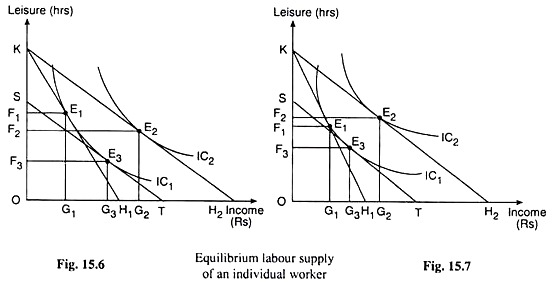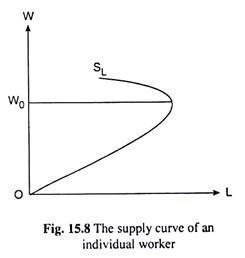In this article we will discuss about the application of Indifference Curve (IC) analysis to solve the problem of analysing the supply of labour of an individual worker.
We may apply the indifference curve (IC) analysis to the problem of analysing the supply of labour of an individual worker. We shall see that the labour supply curve of an individual worker may be sloping upward towards right initially and then, as the wage rate (W) rises beyond a certain level, the supply curve may be backward bending. One such curve has been shown in Fig 15.8.
Here, the worker is confronted with two goods, viz., income and leisure. Indifference curves between income and leisure give us the worker’s preference-indifference pattern between the goods. Both these goods are of more-is-better type, i.e., the marginal utilities (MUs) of both the goods are positive. That is why these ICs would be negatively sloped, and higher ICs would represent a higher level of utility.
Also, to get an extra unit of income, the consumer would be willing to forego smaller amounts of leisure to keep his level of utility, unchanged, i.e., the marginal rate of substitution of income for leisure would be diminishing as the consumer goes on substituting income for leisure.
ADVERTISEMENTS:
That is why the ICs would be convex to the origin. Also, consistency demands that the ICs would be non-intersecting curves. We shall also assume here that both the goods are normal goods.
Let us now note that the price of Re 1 of income is Re 1. The price of one hour of leisure, on the other hand, is the (hourly) rate of wage (W) itself. This is because, to get one additional hour of leisure, the worker would have to supply one hour less of labour and his income would be less by W.
Let us now refer to Fig. 15.6 where the ICs between income and leisure have been given. Let us also note that if the consumer takes zero of income, he may have 24 (OK) hours of leisure and if he takes zero hours of leisure what amount of income he would be able to earn would depend upon W. Let us suppose this amount of income is OH1.
Therefore, the worker’s budget line here would be the line KH1. He may have any income-leisure combination on this line including the points K and H1. The numerical slope of the budget line KH1 is Ok/OH1 which is the reciprocal of the price per hour of leisure, OH1/OK, or, the rate of wage (= W1, say).
ADVERTISEMENTS:
Now, in Fig. 15.6, when W = W, and the budget line is KH1, the worker is in equilibrium at the point of tangency E1 on IC1. At E1, the worker has OG, of income and OF, of leisure. That is, at W = W1 the worker supplies KF1 (= OK – OF1) hours of labour.
Let us now suppose that W rises from W1 to W2, and consequently, the worker’s budget line becomes KH2. The worker now would be maximising utility at the point of tangency E2 on a higher IC1 viz., IC2 (since his real income has increased), having OG2 of income and OF2 of leisure.
That is, at W = W2, the worker supplies KF2 (= OK – OF2) hours of labour. Since KF2 is greater than KF1, we have obtained here that as the rate of wage rises, the worker increases his supply of labour. Therefore, here, the worker’s labour supply curve has been obtained to be upward sloping.
In order to understand why the worker’s supply curve has been obtained to be upward sloping (positively sloped), and when his supply curve may be backward bending, we have to break up the total effect (TE) of the rise in W (i.e., of the rise in the price of leisure), which is represented by the movement of his equilibrium point from E1 to E2, into a substitution effect (SE) and an income effect (IE).
ADVERTISEMENTS:
To obtain the SE, let us allow the worker the rise in W from W1 to W2 at the initial equilibrium point E1, but let us not allow him, for the time being, the consequent gain in real income. Under the circumstances, the worker would have a budget line, ST, that would be parallel to KH2 but tangent to IC, at the point E3.
The movement from the point E1 to the point E3 along IC1 represents the SE of the change in the relative prices of leisure and income (caused by the rise in W), the worker’s real income remaining constant. At E3, as compared to the point E1, the worker would have G1G3 more of income and F1F3 less of leisure—he would substitute the relatively cheaper commodity, income, for the relatively dearer commodity, leisure.
As a result, owing to the SE of the rise in W, the supply of labour would increase from KF1 to KF3. However, after isolating the SE from the total effect, let us now allow the worker the gain in his real income which has occurred owing to the rise in W. As a consequence, the worker’s budget line now would shift from ST to KH2 and his equilibrium point would move from E3 to E2, owing to the income effect (IE) of the rise in W.
As a result of this effect, the consumer would have G3G2 more of income and F3F2 more of leisure. Since his income has increased, he is now having more of both the goods.
However, here the IE-rise in leisure has been less than the SE-fall in leisure, because the worker does not yet think it worthwhile to have more of leisure in the net now that his W has increased. So here, there has been a net fall in the amount of leisure and a net increase in the supply of labour by F1F2 (= F1F3 – F2F3) owing to the rise in W.
We have seen above that, owing to a rise in W, if the SE-fall in the amount of leisure is larger than the IE-rise in it, then the supply of labour would rise and the worker’s supply curve would be upward sloping.
Now, if the opposite happens, i.e., if there is a rise in W, and as a result, the IE-rise in leisure is larger than the SE-fall in leisure, then there would be a net rise in leisure and a net fall in the supply of labour. This may happen if W rises beyond a certain level and the worker thinks himself sufficiently rich to have more of leisure in the net.
Since, in this case, as W rises, the supply of labour falls, the worker’s supply curve of labour would be backward bending. This case has been illustrated in Fig. 15.7. In this figure, as we may see, the IE-rise in the amount of leisure (F2F3) has been larger than the SE-fall (F1F3). So as a result of a rise in W, there has been a net increase in the amount of leisure, i.e., a net fall in the supply of work by F2F3 – F1F3 = F1F2 hours.
ADVERTISEMENTS:
The supply curve (SL) of an individual worker has been shown in Fig. 15.8. As we have analysed above, as W rises initially, the worker’s supply of labour increases. This goes on as long as the magnitude of the IE-rise in the amount leisure is less than the SE- fall.
As W rises beyond W0, the supply curve becomes backward bending—now, as W rises, supply of labour falls. This happens, because now the magnitude of the IE-rise in the amount of leisure is larger than the SE-fall

